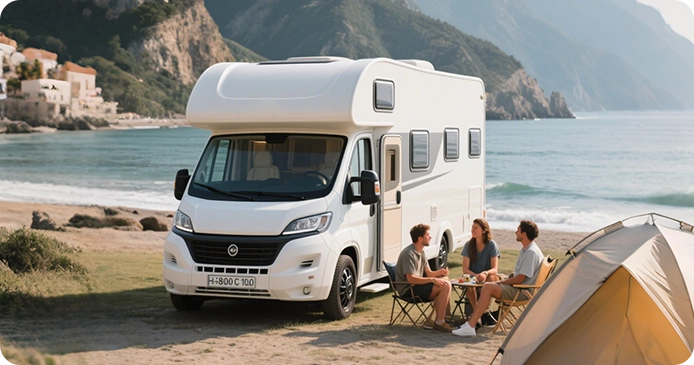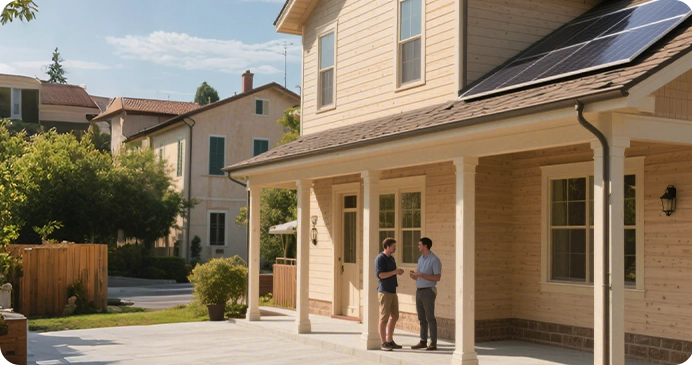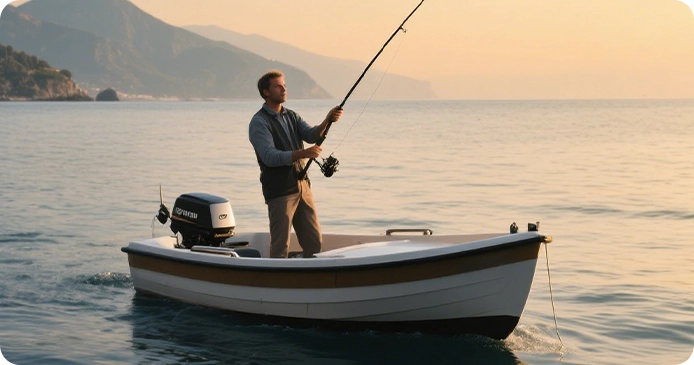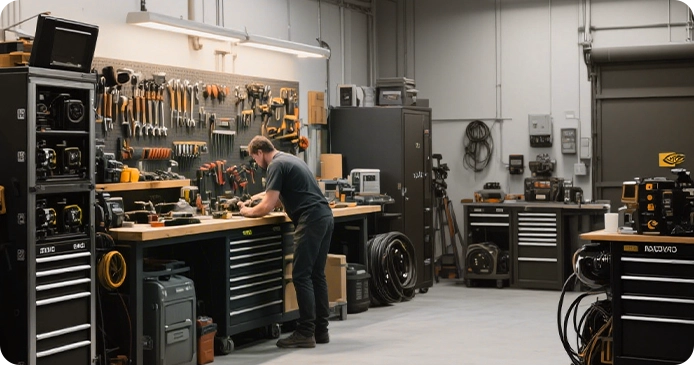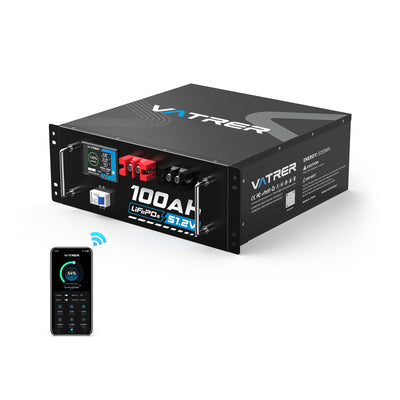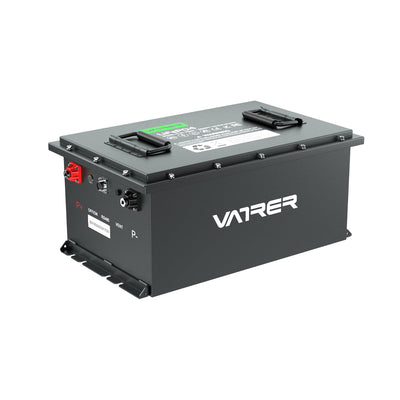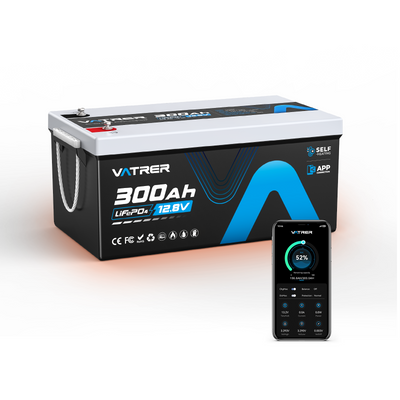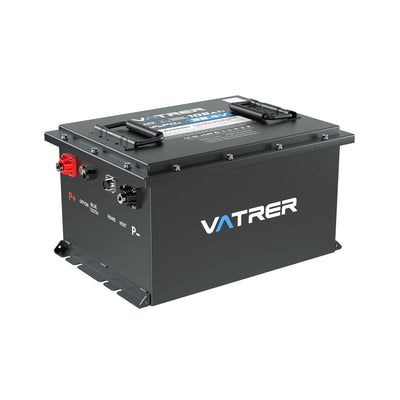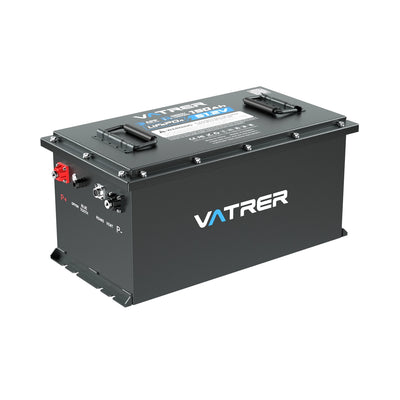What Is a Deep Cycle Marine Battery: Your Guide to Boat Power
Reading time 11 minutes
A deep-cycle marine battery is designed to deliver steady energy for hours, powering trolling motors, fish finders, lights, and other onboard electronics without faltering. Unlike standard marine batteries, these are built for endurance, ensuring you stay powered on the water.
Whether you're casting lines on a fishing boat, cruising on a yacht, or living off-grid on a sailboat, reliable power keeps your adventure on track.
This guide will help you gain a more complete understanding of what deep-cycle marine batteries are, allowing you to choose the most appropriate deep-cycle marine battery for your needs.

What Makes Deep Cycle Marine Batteries Unique
A deep-cycle marine battery provides a consistent flow of power over a longer period of time, ideal for running onboard systems like GPS, radios, refrigerators, and trolling motors.
Unlike marine batteries used for starting engines, which deliver short bursts of high power, deep-cycle batteries excel at deep discharge, safely using 80% or more of their capacity.
For example, a 100Ah deep-cycle marine battery can power a trolling motor for 6-8 hours at medium speed, while a starting battery would overheat in the same role.
These marine batteries are built for durability, using thicker lead plates in traditional designs or advanced lithium materials to handle the vibrations, moisture, and temperature swings of marine environments.
Common options include 12V marine deep cycle battery models for smaller boats and 24V deep cycle marine battery models for larger vessels with higher power demands. They're designed to be discharged and recharged repeatedly, making them perfect for sustained use in marine rv deep-cycle battery applications.
Deep Cycle vs. Starting Batteries
Starting batteries, or cranking batteries, are like sprinters, delivering a quick burst to start your boat's engine, for instance, igniting a 50hp outboard motor in seconds. In contrast, deep-cycle batteries are marathon runners, providing steady power for hours. Using a starting battery for electronics like a trolling motor leads to overheating and a short lifespan, while a deep-cycle battery may struggle to start an engine due to limited instant power.
Dual-purpose batteries combine some features of both, but often underperform compared to dedicated deep-cycle marine batteries for long-term use or marine batteries for starting. For most boaters, using separate batteries for each function ensures reliability and efficiency.
Essential Deep Cycle Marine Battery Terms You Must Know
Understanding battery specifications is crucial when shopping for a deep-cycle marine battery. Here are the essential terms:
- Amp Hour (AH): Measures energy storage. A 100Ah deep-cycle marine battery can supply 10 amperes for 10 hours or 5 amperes for 20 hours, ideal for running a fish finder and lights on a small boat.
- Cycle: One full discharge and recharge. Deep-cycle batteries support thousands of cycles, unlike starting batteries, with a few hundred.
- C Rate: Indicates charge/discharge speed. A 0.5C rate on a 100Ah battery (50A discharge) powers a 20A trolling motor for about 5 hours, while a 1C rate empties it in 1 hour.
- Depth of Discharge (DOD): Percentage of capacity used. Draining a 100Ah battery to 20Ah (80% DOD) is safe for deep-cycle batteries. Long-term over-discharge will shorten the battery life.
- Internal Resistance: Lower resistance improves efficiency. High resistance causes heat, reducing charging performance.
- State of Charge: Percentage of remaining charge. A 100% state indicates a fully charged battery ready for use.
These terms help you compare options like a group 24 deep cycle marine battery or a group 31 deep cycle marine battery to match your boat's power needs.
Exploring Types of Deep Cycle Marine Batteries
Deep-cycle marine batteries come in various chemistries, each suited to different boating needs. Here's a detailed comparison:
Flooded Lead-Acid (FLA) Batteries
Lead-acid deep-cycle batteries use free-flowing liquid electrolytes (a mix of sulfuric acid and water) with lead plates. They're affordable and widely available, often used in marine rv deep-cycle battery setups or golf carts.
- Pros: Cost-effective ($100-$150 for a 12V marine deep cycle battery), 99% recyclable, reliable with proper care.
- Cons: Heavy (50-80 lbs depending on size, like group 24 vs. group 31), requires maintenance (regular refilling of water), sensitive to vibration damage.
Gel Batteries
Gel batteries use gelled electrolytes, making them maintenance-free and spill-proof, ideal for rough seas.
- Pros: Low self-discharge (1% per month), flexible installation (except upside down), vibration-resistant.
- Cons: Higher cost ($200-$300), lower capacity for size, needs a specific charger, less effective at high discharge rates.
Absorbent Glass Mat (AGM) Batteries
AGM deep cycle marine battery models use fiberglass mats to hold electrolytes, offering a sealed, maintenance-free design.
- Pros: Spill-proof, fast recharge, vibration-resistant, 3% self-discharge per month, versatile for deep cycling and occasional starting.
- Cons: More expensive ($150-$250), sensitive to overcharging, shorter lifespan for cost compared to lithium.
Lithium (LiFePO4) Batteries
Lithium-ion deep-cycle marine battery options, particularly LiFePO4, use lithium iron phosphate for advanced performance.
- Pros: Lightweight (up to 70% lighter, like 25 lbs vs. 80 lbs for lead-acid), maintenance-free, fast charging, long lifespan (3,000-4,000 cycles at 80% DOD in typical marine conditions, or 8-10 years), includes a Battery Management System (BMS) for safety.
- Cons: Higher upfront cost ($250-$400 for a 12V 100Ah), requires a lithium-compatible charger.
This table helps you compare options, guiding your choice based on boating needs.
| Battery Type | Key Features | Best For |
|---|---|---|
| Flooded Lead-Acid | Affordable, recyclable, reliable with maintenance | Budget-conscious boaters with smaller vessels |
| Gel | Spill-proof, low self-discharge, vibration-resistant | Small boats with limited maintenance capacity |
| AGM | Maintenance-free, versatile, fast recharge | Mid-sized boats needing reliability |
| Lithium (LiFePO4) | Lightweight, long-lasting, safe, fast-charging | Performance-driven boaters, larger vessels |
Why Deep Cycle Marine Batteries Excel for Boating and Trolling Motors
- Sustained Power: Provide steady energy for long-period use, such as running a trolling motor for 6-8 hours of fishing or powering appliances on a liveaboard yacht.
- Durability: Engineered to withstand vibrations, moisture, and temperature swings ( 0–50°C), ensuring reliability in rough seas.
- Versatility: Fits various vessels, from a kayak using a group 24 deep cycle marine battery for a compact trolling motor to a yacht needing a 24V deep cycle marine battery for multiple systems.
- Long Lifespan: Lithium-ion deep-cycle marine battery options last 2-4x longer than lead-acid, reducing replacement costs.
- Safety (Lithium): LiFePO4 batteries feature a BMS to prevent overcharging, overheating, and short-circuiting, ensuring safe operation on the water.
A 100Ah deep-cycle marine battery in lithium can power a 30 lbs thrust trolling motor for 6-8 hours at medium speed, while a lead-acid version may last only 4-5 hours before needing a recharge.

How to Choose the Best Deep Cycle Marine Battery
Selecting the best deep-cycle marine battery involves matching performance to your boat's needs and budget. Here's a detailed guide:
Battery Capacity (Amp Hours)
Choose an AH rating based on your devices'energy needs. For example, a bass boat with a trolling motor (20A) and fish finder (2A) used for 5 hours needs about 110Ah (22A x 5h).
Add a 20% buffer for efficiency losses, making a 100ah deep cycle marine battery suitable for smaller setups, while larger yachts may require a 24v 200ah battery.
You can use online tools like Vatrer's capacity calculator or consult a marine dealer to size accurately, aiming for 50% Depth of Discharge (DOD) to extend lifespan.
Discharge Rate (C Rate)
Select a C rate based on usage. A lower rate (0.5C) suits long period use like trolling, providing steady power over hours. Higher rates (1C) are better for shorter, intense demands but are less common in deep cycle applications.
Cycle Life
Prioritize high cycle life for longevity. Lithium-ion deep-cycle marine battery models offer 3,000-4,000 cycles at 80% DOD in typical marine conditions (25°C, proper charging), compared to 300-400 cycles at 50% DOD for lead acid deep-cycle batteries. This makes lithium ideal for frequent boaters.
Size and Weight
Match battery size to your boat's compartment using Battery Council International (BCI) group sizes. A group 24 deep cycle marine battery (10.25 x 6.81 x 8.88 inches) fits small boats like kayaks, while a group 31 deep cycle marine battery (13 x 6.72 x 9.44 inches) suits larger vessels. Lithium batteries reduce weight significantly, improving fuel efficiency for performance boats.
This table ensures compatibility with your boat's setup, complementing the selection process. Also, explore the Vatrer marine trolling motor battery range to find out more options that suit your needs.
| BCI Group Size | Length (in) | Width (in) | Height (in) | Best For |
|---|---|---|---|---|
| Group 24 | 10.25 | 6.81 | 8.88 | Small boats, kayaks, compact trolling motors |
| Group 31 | 13 | 6.72 | 9.44 | Larger boats, yachts, multiple appliances |
Budget and Long-Term Value
Lead acid deep cycle batteries are cheaper upfront ($100-$150) but last 3-5 years, while lithium batteries ($250-$400 for a 12V 100Ah) last 8-10 years. For example, a $300 lithium battery with 3,000 cycles costs $0.10 per cycle, compared to $0.30 per cycle for a $120 FLA battery with 400 cycles, making lithium more cost-effective over time.
Installation Needs
Check your boat's battery tray dimensions and weight limits. A sailboat with limited space may benefit from a compact group 24 deep cycle marine battery in lithium, while a fishing boat with a larger compartment can use a group 31 deep cycle marine battery or a larger capacity 24V lithium battery. AGM deep-cycle marine batteries and gel options allow sideways installation, while lead-acid batteries need ventilation to prevent gas buildup.
Caring for Your Deep Cycle Marine Battery for Longevity
Proper care maximizes the lifespan of your deep cycle marine battery. Please follow the method below:
- Check Connections: For lead acid deep cycle batteries, inspect terminals monthly for corrosion and clean with a baking soda and water solution. Tighten loose connections to ensure efficient power transfer.
- Smart Charging: Use a charger matched to your battery type (like 14.4V for 12V LiFePO4, 14.7V for AGM). Leverage deep discharge capabilities but avoid overcharging with automatic shutoff chargers. The Vatrer charger provides three levels of intelligent protection, all to provide higher security and safe charging.
- Storage: Store batteries in a dry, cool place (32–80°F or 0–27°C), away from humidity. Label them for easy identification during off-season storage.
- Lithium Care: Vatrer LiFePO4 batteries require minimal maintenance due to their BMS and low-temp cutoff. Use a compatible charger and check the state of charge periodically (via BMS apps or indicators if available). Avoid storing at 0% charge to maintain battery health.
Finding the Right Deep Cycle Marine Battery
Choosing the best deep cycle marine battery means aligning performance, cost, and boat-specific needs. Whether you're powering a trolling motor on a bass boat or running appliances on a liveaboard yacht, understanding battery types and specifications is crucial.
For top performance, consider lithium-ion deep-cycle marine battery options from Vatrer. Our LiFePO4 batteries, like the 12V 100Ah (Group 24) starting or 24V 200Ah for larger setups, offer lightweight design, up to 4,000 cycles, and safety features like BMS and low-temp cutoff, ideal for demanding marine environments.
Vatrer provides free consultations to help match batteries to your needs. For personalized advice, use online capacity calculators to ensure worry-free boating with reliable power for years.
Want to learn more about marine batteries? You can also read the following:
What is a Group 24 Deep Cycle Battery?
Can I use a Deep Cycle Battery for LiveScope?
How long do Deep Cycle Batteries last?
Where to buy Deep Cycle Batteries near me
What is the best Deep Cycle Battery?
People Also Ask/FAQs
How Do You Charge a Deep-Cycle Marine Battery?
Charging a deep-cycle marine battery requires a charger compatible with its chemistry. For lead acid deep cycle batteries (FLA or AGM), use a charger with a voltage of 14.4-14.7V and an automatic shutoff to prevent overcharging.
For lithium-ion deep-cycle marine battery models (LiFePO4), select a charger set to 14.4V for a 12V marine deep-cycle battery or 28.8V for a 24V deep-cycle marine battery, ensuring it supports lithium profiles. Charge at a moderate rate (0.2C-0.5C) to maintain battery health, and avoid charging in extreme temperatures (below 32°F or above 113°F).
Should You Run a Marine Radio On a Deep-Cycle Battery?
Yes, a marine radio is ideally powered by a deep-cycle marine battery due to its need for consistent, low-current power over extended periods. Radios typically draw 1-5A, making them perfect for the steady output of a 100Ah deep-cycle marine battery or even a group 24 deep-cycle marine battery. Using a starting battery risks overheating and premature failure. Ensure the battery's capacity matches the radio's runtime needs, and consider a lithium-ion deep-cycle marine battery for longer-lasting, maintenance-free operation.
What Type Of Battery Is a Marine Deep Cycle?
A deep cycle marine battery is specifically designed for sustained power delivery, capable of deep discharge (up to 80% of capacity) and repeated cycling. Types include lead acid deep cycle batteries (Flooded Lead-Acid or AGM), gel batteries, and lithium ion deep cycle marine battery (LiFePO4). Unlike starting batteries, which use thinner lead plates for short bursts, deep cycle batteries have thicker plates or advanced lithium chemistry for durability in applications like trolling motors or marine rv deep cycle battery setups.
What is a Group 27 Deep Cycle Battery?
A Group 27 deep cycle battery is a deep cycle marine battery sized according to Battery Council International (BCI) standards, typically measuring 12.06 x 6.81 x 8.94 inches. It offers a capacity range of 80-100Ah, making it suitable for mid-sized boats needing more power than a group 24 deep cycle marine battery but less than a group 31 deep cycle marine battery. It's ideal for running trolling motors, fish finders, and lights on fishing boats or small cruisers, available in AGM or lithium chemistries for maintenance-free performance.
What is a Group 31 Deep Cycle Battery?
A Group 31 deep cycle marine battery is a larger BCI-sized battery, measuring 13 x 6.72 x 9.44 inches, with capacities of 100-120Ah. It's designed for larger vessels, such as yachts or boats with multiple electronics, powering high-demand systems like refrigerators or 24V deep cycle marine battery setups. Available in AGM deep cycle marine battery or lithium options, it offers robust performance and, in lithium, significant weight savings for improved fuel efficiency.
Are Marine Batteries Deep Cycle?
Not all marine batteries are deep cycle. Marine batteries include starting batteries for short bursts to ignite engines, deep cycle batteries for sustained power in electronics, and dual-purpose batteries for both functions. Deep cycle marine batteries, like AGM deep cycle marine battery or lithium-ion deep cycle marine battery, are designed for long period use and repeated discharged and recharged cycles, unlike starting batteries, which prioritize instant power delivery.
Share




























